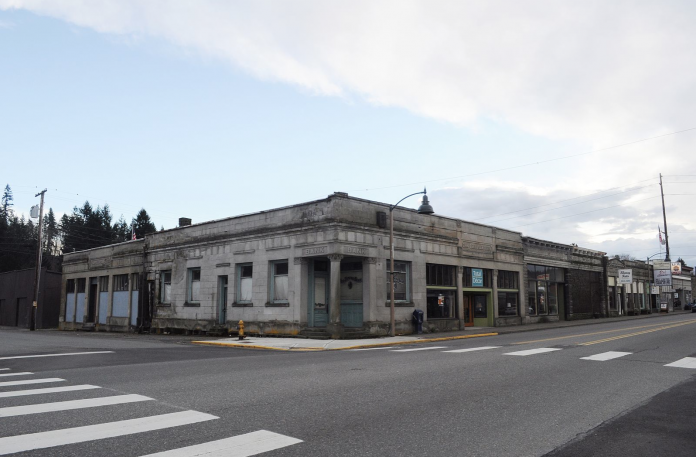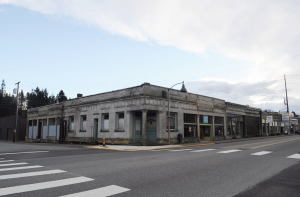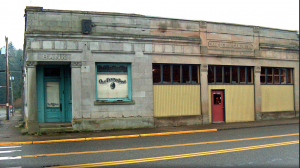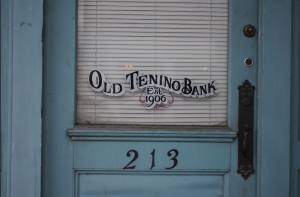
By Emmett O’Connell
 The State Bank of Tenino is the corner portion of a larger structure called the Campbell and Campbell Building. The building was constructed in 1906 by the Campbell siblings, a brother and sister duo who worked in one of Tenino’s grocery stores in the 1890s. In 1899 Belle Campbell (who also served as the town’s post mistress) and A.D. Campbell went into business together.
The State Bank of Tenino is the corner portion of a larger structure called the Campbell and Campbell Building. The building was constructed in 1906 by the Campbell siblings, a brother and sister duo who worked in one of Tenino’s grocery stores in the 1890s. In 1899 Belle Campbell (who also served as the town’s post mistress) and A.D. Campbell went into business together.
They located their store on the south end of their new sandstone building at the corner of Olympia and Sussex Avenue. The same year, their previous location was lost in a devastating fire that had leveled the block just north of their new location.
The corner portion, which housed the State Bank of Tenino, was completed in 1908.
Like many important buildings in Tenino, the Campbell and Campbell building (and city hall, the train depot and more than a few houses) is made out of the local sandstone.

The origin of Tenino sandstone, and every major sandstone deposit in Washington State, dates back to at least 40 million years ago during the Eocene Epoch, when our region was a flat subtropical bayou and plain. Thick deposits of sand built during that era eventually became sandstone, which in turn helped build Washington State, but especially Tenino itself.
Beginning soon after statehood, a series of devastating fires demolished pioneer era blocks in cities across the state. Buildings began looking for a more permanent material. One such material was Tenino sandstone.
The Tenino quarries supplied sandstone for buildings as far east as Montana and as far south as Stockton, California. As the Campbell siblings rebuilt from their own small tragedy, Tenino sandstone was being shipped south to help San Francisco rebuild from the devastating earthquake that nearly destroyed that city.
Up until the 1920s, when concrete began to take over as a cheaper and more functional building material, the Tenino economy ran on sandstone. Sandstone quarries began failing in the 1920s and the last quarry shut down in 1938.
As a sidenote, that last quarry reopened again in the 1990s, supplying mostly small batch sandstone to artisans.

In the 1930s, the Campbell’s building came into prominence again in Tenino, helping the community build itself back up as the Great Depression set in. While the decline of sandstone had already hurt Tenino, the collapse of the greater economy hit Tenino especially hard. Citizen’s Bank of Tenino failed (which was earlier known as State Bank of Tenino), taking the deposits of local residents with it. To respond, the Chamber of Commerce issued local script, insuring 25 percent of a depositor’s bank balance. This script eventually took the form of slices of cedar and spruce, which by themselves became notorious collector’s items. While they circulated locally as currency in the early 1930s, only $40 worth of the more than $10,000 that were issued were ever redeemed to the chamber.
By 1939, the Chamber of Commerce had taken control of the bank portion of the building and deeded it to the city. The city used the old bank as a city hall until 1947.
The Campbells closed their store in 1954, however the space was operated as a grocery store until the 1970s.
Since then, the building has been used as a law office, real estate business, barber shop, event center and antique store (among other uses). Over the last three years, its current owners — Steve and Sharon Thorniley — have painstakingly restored the old bank portion of the building.

The Thorniley’s did most of the restoration by themselves. Steve is a retired union carpenter. The couple’s work earned them an award from the Washington State Department of Archeology and Historic Preservation.
Sharon Thorniley drove past the Old Tenino Bank almost every day for years while wishing that someone would step up and return the magnificent stone structure back to full function. Four years ago, Sharon took the first steps to making that wish come true—she convinced her husband Steve that they were the ones to do it. They bought the building which was merely a stone shell and began the process of rehabilitation. Most people in Tenino thought they were crazy but the two worked diligently to clean up the debris, and rid the block of vermin. The couple has done their best to employ the best and most talented labor to preserve the historic nature of the structure which was constructed as a showcase of quality of locally sourced Tenino sandstone as a building material.
The restoration even includes a new sandstone sign in front of the building. It was carved by the town’s last stonemason, Keith Phillips. The stone for the sign came from the quarry that supplied the stone for the building itself.
Chris Hallett, an Edward Jones financial advisor, currently resides in the old bank space. He has painstakingly collected historic artifacts from the town, including several examples of the old wooden script. “We were lucky to be in the right place at the right time,” Hallett said. “We wanted to make this office like an extension of the museum, to really showcase the history of the town.”
Hallett was even able to track down an old newsreel on the town’s wooden money that he shows on a loop in his office.
Further Reading:
Department of Archeology and Historic Preservation: Campbell and Campbell building


















































